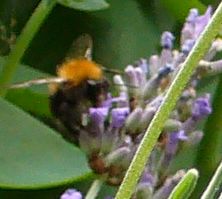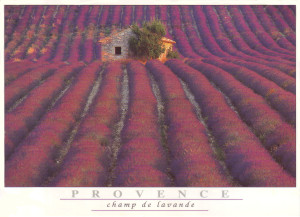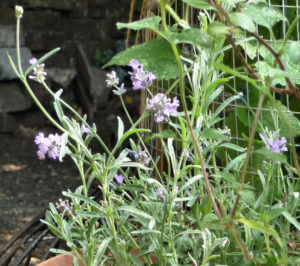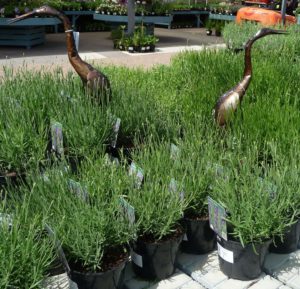LAVENDER (Lavandula angustifolia)
 W Mediterranean
W Mediterranean
Lavender is a Mediterranean shrub/herb, known and valued worldwide for its fabulous fragrance. This plant is fully drought tolerant & thrives in full sun.
Spikes of small LAVENDER flowers appear on stems of silver-grey or grey-green foliage from July to September.
Plant in a sunny spot, preferably south or west facing. Soil most favoured is chalky, alkaline, free-draining. Use plenty of sand and gravel to increase drainage.
How to Grow Lavender; A Beginners Guide https://sfuaa.org/lavender/
Bees’ favourite.
We have had success with ‘English Lavender’, Lavandula angustifolia ‘Hidcote’. Tiny florets of DARK VIOLET bloom on stems of aromatic grey-green, 12-23 inches in height, attracting the bees.
Herbal
Known as Spikenard to the Ancient Greeks, in India and in the Bible, Lavender is used in aromatherapy to ease stress and calm the mind.
Lavender Stachaedoes (French lavender), Lavandula officinalis: “The buds, mixed with marjoram, clove, carnation, betony, and rose leaves and worn around the neck in a bag will cure headache”. Jeanne Rose’s Herbal, HERBS & THINGS, Grosset & Dunlap, Workman Publishing Company, New York 1973.
“Lavender oil is said to soothe headaches, migraines and motion sickness when applied to the temples. It is frequently used as an aid to sleep and relaxation.” http://www.lavendersense.com/index.php/Lavender/Index History and Uses of Lavender – Lavender Sense Browse Mozilla Firefox
Herbalist Terri Conroy shows how to make soap with lavender on her website Danu’s Irish Herb Garden.
Lavender in History
Historically, Lavender was first thought to have been used over 2500 years ago by the Egyptians for mummification & perfume. In ancient Greece, Dioscorides knew that it healed wounds, being antibacterial & antiseptic.
It was grown in England by the Romans & used for cooking & bathing. The name ‘lavender’ is from ‘lavare’, to wash. When the Romans left, the growing of Lavender was taken up by the monks in their physic gardens.
A natural insect repellent, Lavender was tied to the wrists to repel plague in the Middle Ages. Crosses of Lavender flowers were hung on doors to ward off evil. http://www.cotswoldlavender.co.uk/info/all-about-lavender/history-and-folklore/
Lavender at Highbury
Two large pots of Lavender, from the balcony of my previous flat, were planted out in the garden here in 2001. Lavandula Angustifolia, the ‘English’ Lavender with soft BLUE flowers on blue-grey stems and leaves, lasted for years. Lavandula Stoechas, the ‘French’ or ‘Spanish’ Lavender with MAGENTA ‘rabbit-ears’, succumbed to downy mildew after a season in London. Its successors suffered the same fate.





